This grand dame from the 1950s is going, and I decided that I have to blog about it.
Huh, but the nonsensical title?
You see, if you first come across the name, you'd think the hotel has only seven storeys. Ok, maybe not so because of the difference between ordinal and cardinal numbering. It is seventh storey, not seven storeys. But the human mind often works by association, so putting a number and a noun together will give the impression of having x-number of that noun.
Luckily the Chinese name is not that confusing. "七层楼酒店" means seven storeys hotel. So 7th Storey Hotel should be a seven storeys hotel.
Until you read what the articles say.
Take the June 27 ST when the groundbreaking news was announced, "55-year-old hotel to make way for MRT":
The hotel, which actually has nine storeys despite its name, was opened in 1953 by the late property magnate Wee Thiam Siew.So it is actually a nine storeys hotel.
Since only seeing is believing, I went down for a look.
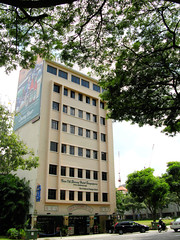
Picture from opposite side of Rochor Road. For half a century, cars and pedestrians have drove or walked past the hotel. How many have counted whether the storeys match up to the name?
From the front side, you count only eight storeys. You can include the rooftop but this is definitely not the convention.
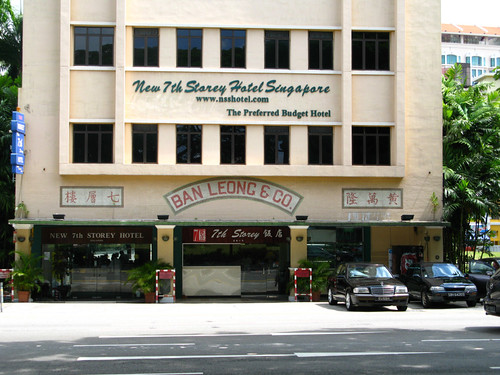
Close-up of the entrance
The above shot is interesting for two reasons.
First, the discrepancy between the English and Chinese names. The name change to New 7th Storey Hotel is not consistently reflected in the Chinese version, i.e. 新七层楼酒店. According to this article, the name change was to rebrand itself targeting backpackers and avoiding competition with international branded hotels. I'm guessing the name change is more of marketing tactic than change in identity. In that case, will the hotel be called New New 7th Storey Hotel in future?
Second, a cursory glance at the ground floor does not tell you that the building is a hotel. For example, it is more logical to think that the building is owned by Ban Leong and has seven storeys. The sign arc is so prominent! According to Peter Chan (quoted by Victor in his blog comments), Ban Leong had a tyre shop at the hotel in the 1960s, which explains the sign. Under the Ban Leong sign, at the center, you'd expect to find the entrance to the building, which happens to be a restaurant in this case (7th Storey 饭店).
I'm not sure how this Ban Leong is related to the Ban Leong known by most people, especially IT geeks. To contact this Ban Leong, you can use the Internet Yellow Pages. Search under Name/Phone for "Ban Leong (1961) Pte Ltd". Guess where is their office?
The Internet Yellow Pages classifies them as a tobacco dealer. Right, they distributed the 555 Brand cigarettes, according to this article. But do they still do tyre business? The closest Ban Leong doing tyre business is this Syarikat Ban Leong in Malaysia. Again, are they related?
Back to exploring the hotel. To find the last storey, you have to do like what Victor wrote in his blog - go to the backside.
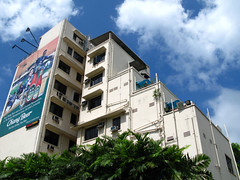
The hotel from the back
Indeed, what appears as the rooftop from the front side is not the rooftop yet. The hotel looks different from the front and back. The architectural gems, like the terrace design and "hidden" top level, are not visible from the front face.
From the side, you find one of the hotel's treasure, its spiral staircase.
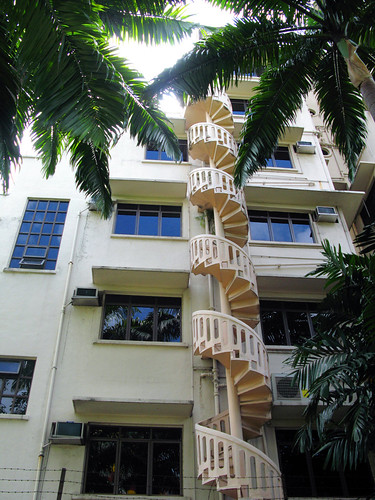
The hotel's quaint spiral staircase
The hotel is not very big. Take a few steps from the spiral staircase and you're back at the front.
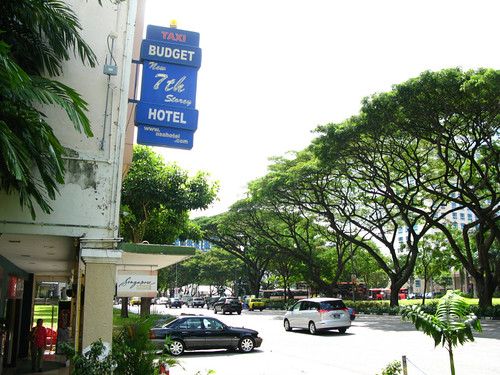
The hotel is next to the road. There is no multi-storey carpark.
This ends my rather short coverage of the hotel. If you want to see photos of the interior, try the blog by Ah Leng or simply the photo gallery on their official website.
As to how the hotel got its name and why the name is still valid despite having nine storeys, I offer you three perspectives.
From me:
My initial hypothesis was that the hotel has seven storeys and its name and reality do match. The trick is in the definition. According to wikipedia:
In British English, in reference to typical buildings, the "first floor" is the first floor above the ground; but in American English, it is another name for the ground floor.
Most European countries, Latin American countries, countries of the Commonwealth (except Singapore and parts of Canada, which use the American system), and former British colonies like Hong Kong, follow the same convention as the British. Finland, Norway, Russia, some countries of East Europe, and most of eastern Asia (including China and Japan) have a convention similar to the American system.
Thus, from the front face at least, the hotel has seven storeys (according to British system). The top storey is more of a rooftop space. I'm thinking it is out of bounds to guests. From a 2002 ST article:
In case you ever wondered: the 7th Storey Hotel at 229 Rochor Road doesn't have only seven floors. There are nine levels, including a rooftop space and a tiny shed to house its lift engine..
Though Singapore now follows the American system, it is possible that in the early days, the British system was followed. There was heavy British usage of the hotel - in the 50s and 60s British officers used the top floor for cha cha parties.
How can we test the hypothesis? The most direct way is to check the hotel's lift numbering. In my mind, there are two possible patterns:
G, 1, 2, 3, 4, 5, 6, 7, (x)
1, 2, 3, 4, 5, 6, 7, 8, (9)
The first is how the British system could be represented. The second is the familiar Singapore system. Since I'm not sure whether the top storey is accessible by the lift, I put them in brackets.
To verify my guess, I made a second trip to the hotel. This time to the interior.
The hotel is famous for its fully manual "cage" lift. You can read and see photos of it elsewhere. I just show you the lift numbering here. In fact, this is the only photo I've taken of the hotel interior. The staff must be thinking I'm weird.
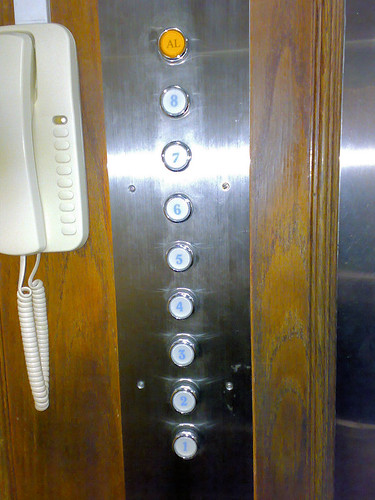
Storey numbering inside the cage lift
Oh no! Singapore system ....
The 'AL' button got me stuck for some time, until I realize it is the alarm button. Should be lah.
From public domain:
The ST article "Hard to say goodbye" on July 6 told us:
Contrary to its name, the New 7th Storey Hotel has nine storeys. Its operations manager, Ms Shirley Fong, 32, explains that the owner had decided on the name when architectural plans showed that it could be built up to nine storeys.
'The postal code for the hotel then was also just 7,' says Ms Fong, who has been with the hotel for eight years.
The article is unclear on the origin of the name. If the limit is nine storeys, why didn't the owner, presumably Wee Thiam Siew, choose 8th Storey Hotel?
That the postal code was also a 7 is more like a coincidence and auxiliary reason.
Anyway, let's verify whether it was a 7 last time. A shot of an early 1960s street directory:
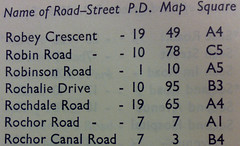
Postal district of Rochor Road
The current address of the hotel is 229 Rochor Road, Singapore 188452. The hotel has always faced Rochor Road, so it had a postal code of 7 last time, 7 being the postal district of Rochor Road.
Nowadays we use the six digits postal code but postal districts are still used by, not postmen but property agents. District 9 and 10, sounds familiar? Here is a website mapping the old postal districts (28 of them) to the new six digits code. The new code has the format ABXXXX. AB represents the postal sector (81 of them). For the hotel, 18 is the postal sector.
Thus, we see there's nothing amazing about having 7 as the postal code last time. Everybody along Rochor Road and Rochor Canal Road has the same postal code as you.
From staff:
You could have guessed why I leave this last. Like they say, save the best for the last.
On the day I went into the hotel to take that only shot of the lift interior, I met this cleaning auntie at the ground floor. I call her auntie out of respect, to differentiate her from other young female staff.
If you remember what happened, I went into the hotel to verify my hypothesis. I was expecting the cage lift to use the British system. If so, I considered my mystery solved and case closed.
But I was disappointed. The quaint cage lift does not use the British system. Nevertheless I took a picture of the lift buttons. It shall be evidence of my failed hypothesis.
I did not give up, however. I pretended to look at the framed newspaper articles on the wall beside the entrance. I wasn't really interested in them as I've read them online. All the while, the auntie was doing her cleaning beside me. As she was friendly to me and even helped arrange my photo taking inside the lift (note I wasn't a hotel guest and they disallow non-guests to use the lift for personal reasons), I felt she could help me. So I bidded my time.
I finally mustered the courage to ask her the question. I asked whether the hotel was like that since the beginning and why it is called 7th Storey Hotel. Why the discrepancy?
Without pause, she replied confidently, "因为八楼是 office".
(Translated, it means 'because the 8th storey is the office')
--------------------------------------------------------------
Guys, which perspective has your vote? :P















5 comments:
like what you said, this post entry really caught my attention. I read everything!!! LOL!!!
And to my amazement by the auntie's fast response, it could jolly well be this way! That all the floors from 1-7 are solely for guests' use and the 8th and maybe 9th floor are for commercial uses.
Li hai!
To me, your discovery is gooD! much more interesting than the others!
Icemoon. As usual, I laud you for your thorough research. Still you missed out some important points regarding the confusion arising from the previous system which only 'oldies' like us would be familiar with.
In the old days, like Msia still is now, there was a lot of confusion becos of the dual system as you pointed out. With the 'G' system, Storey#1 is referred to Ground floor, the Storey #2 is referred to as 1st floor, and so on. Thus some people say 3rd storey, some people said 2nd floor. With such a high proportion of multi-storey buildings in Spore, it led to a lot of problems; especially for the delivery people. So the gahmen wisely decided to standardise to 1 system. At the same time they introduced the Apt Block X, #YY-ZZ system to avoid confusion.
My take of this hotel is that there are altogether 9 storeys including the rooftop. The ground floor is not counted because it is not part of the hotel; again a common practice in the old hotels. For example the famous New World Hotel which collapsed some years ago had a bank in the ground floor. The actual hotel has 7 storeys. Again the roof top is not counted. In Cantonese we say tin toy. or tian tai in mandarin.
Thanks for linking me, Icemoon.
In other countries like China, it is not uncommon for owners to add more floors to (the top of) a completed building. This is highly unlikely to happen in modern-day Singapore because of tight controls by the Building Control Division. However, I am not sure if the situation 53 years ago was already like that.
there never had been a tyre shop in 7th storey hotel. n yes, ban leong was a tobacco dealer.
Thanks Shirley for the info!
For the benefit of other readers, I quote Shirley's comment in Victor's blog:
ban leong is not a tyre shop. It's a cigarette distributor company for 555 n dunhill.Ban Leong n 7 Storey Hotel & Lion City hotel were owned by the same person. Who am I? I am a member from the family.
Post a Comment